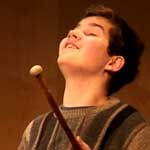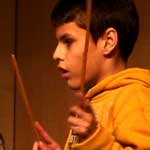Introduction
This book is the result of teaching adults and children over several years, in groups or in individual lessons. It is inspired by traditional rhythmic styles from around the world. In this first book, Brazilian and Ghanaian drumming is highlighted, with a small excursion into the Middle East.
The philosophy behind this book is to give beginners access to sophisticated polyrhythms without the need to encumber the student’s mind with western musical notation and concepts. It is based on an oral transmission of musical knowledge, which is the way these various styles have been passed along for many generations of performers.
I bring into play the various above-mentioned styles in order to introduce the students to contrapuntal rhythmic patterns. I have adopted the use of a phonating system that was developed by Ghanaian drummers. One of the lessons introduces a Middle Eastern beat; but the majority of the lessons rely on a Brazilian rhythm called Samba. By choosing a variety of rhythmic language from different cultures, the students learn a coherent and gradually progressive system that is both entertaining and educational.
Current and ongoing research on the relation of music and the brain are confirming what African drummers (and other styles: Indian tablas and Swiss drumming come to mind) seem to have intuitively known: not only is music closely related to the development of speech, but it seems to have preceded it in our evolutionary history.
One of the strongest relations found between music and the brain is the one that is made between lyrics and melody. Remembering the lyrics of a song will automatically bring back the melody associated to it. This is true even for people who have suffered brain lesions that keep them from remembering the accompanying tune. Melodies that contain lyrics are found to be more easily remembered this way.
In this book, we will use short monosyllabic words that represent the various sounds. These short syllables will always be sung first before the rhythm is played (note- the only time there is no accompanying syllable to sing with a rhythmic pattern is in the calls and answers). The use of these mnemonic devices allows us to recall a large amount of musical data; in particular for rhythms, master drummers in Ghana use them to transmit this knowledge. The principle is to make rhythms into songs that, thanks to our brain wiring, will help us to recall various patterns and rhythms. With repetition these rhythms will become reflexes, instead of relying on the intellectual process of counting beats. It helps the students to free their minds to work on the coordination of their hands and the relation to others in unison first, and then in polyrhythm.
This book is mainly addressed to teachers; it gives a very gradual system to transmit music to beginner musicians. It is not limited to percussionists, but to all who would like to expand their sense of rhythm, and take part in a group. The book is divided into ten lessons of about an hour each. As the teacher comprehends the overall learning level of the group, it may be necessary to review or repeat lessons. Or, depending on the students’ abilities, more than one lesson may be covered in a session. If the latter is the case, once you have achieved a good result at one tempo, you can increase it gradually to make the lesson more challenging. I leave all of this to the discretion of the instructor.
Drumming in its polyrhythmic form can induce a “trance-like” state to the player, in which simple interlocking patterns take on a new level of understanding.
These lessons will develop one’s listening and awareness of the group, train the ear to discriminate between intricate polyrhythmic and interlocking patterns, musical reflexes and hand coordination, all in an entertaining and fun way. At the outset they will be able to perform a small arrangement that will be led by the teacher.
The teacher will have to familiarize him or herself with some basic techniques, and learn the various patterns and calls that he or she will transmit to the students. Although the process of teaching the material is spelled out in great detail, more input and improvisation will be required of the instructor as the class develops, particularly with the arrangement of the percussion pieces and the alternating of the calls and answers.



